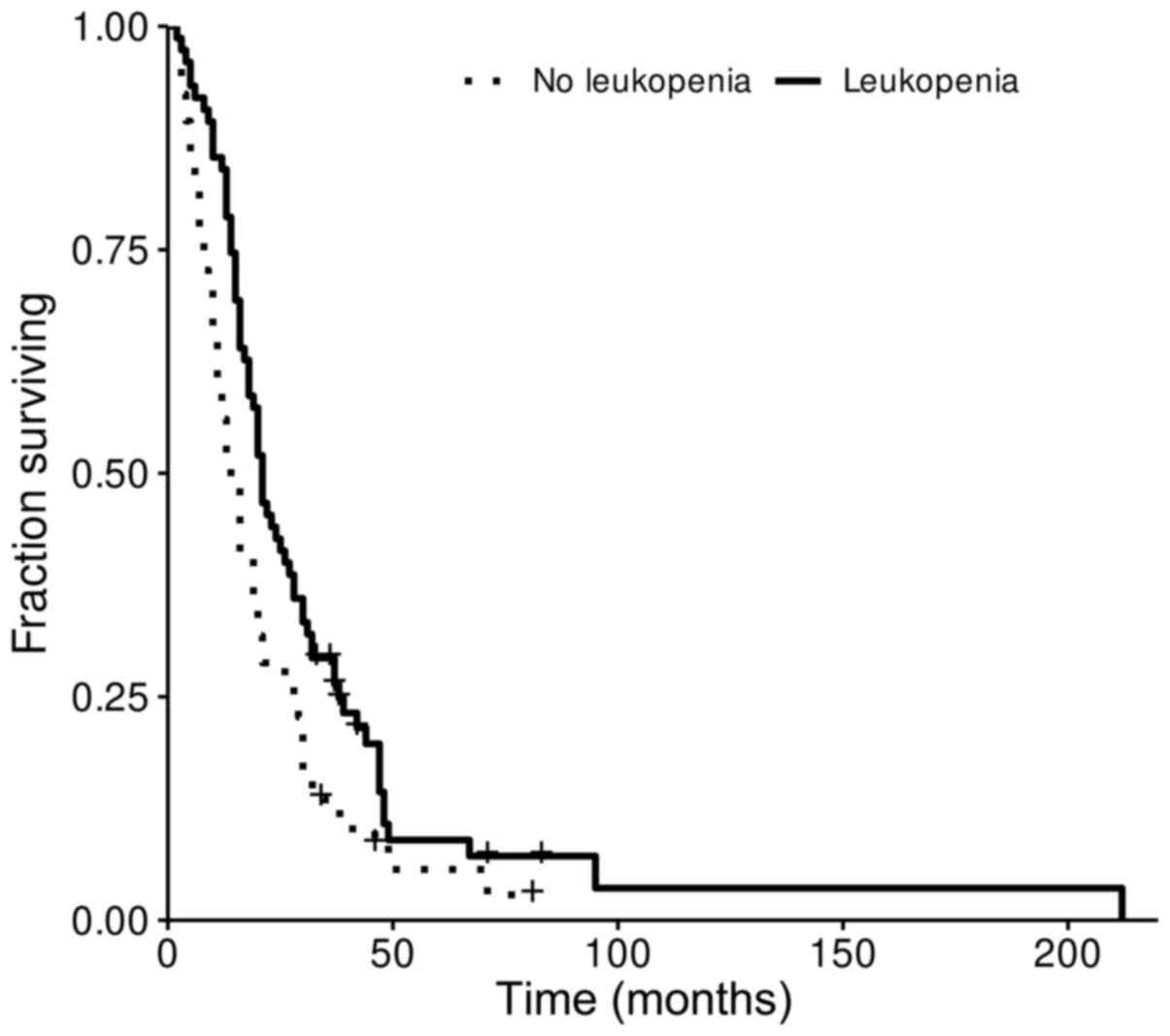|
1
|
Gilbert MR, Wang M, Aldape KD, Stupp R,
Hegi ME, Jaeckle KA, Armstrong TS, Wefel JS, Won M, Blumenthal DT,
et al: Dose-dense temozolomide for newly diagnosed glioblastoma: A
randomized phase III clinical trial. J Clin Oncol. 31:4085–4091.
2013.PubMed/NCBI View Article : Google Scholar
|
|
2
|
Stupp R, Hegi ME, Mason WP, van den Bent
MJ, Taphoorn MJ, Janzer RC, Ludwin SK, Allgeier A, Fisher B,
Belanger K, et al: Effects of radiotherapy with concomitant and
adjuvant temozolomide versus radiotherapy alone on survival in
glioblastoma in a randomised phase III study: 5-year analysis of
the EORTC-NCIC trial. Lancet Oncol. 10:459–466. 2009.PubMed/NCBI View Article : Google Scholar
|
|
3
|
Stupp R, Mason WP, van den Bent MJ, Weller
M, Fisher B, Taphoorn MJ, Belanger K, Brandes AA, Marosi C, Bogdahn
U, et al: Radiotherapy plus concomitant and adjuvant temozolomide
for glioblastoma. N Engl J Med. 352:987–996. 2005.PubMed/NCBI View Article : Google Scholar
|
|
4
|
Tolcher AW, Gerson SL, Denis L, Geyer C,
Hammond LA, Patnaik A, Goetz AD, Schwartz G, Edwards T, Reyderman
L, et al: Marked inactivation of O6-alkylguanine-DNA
alkyltransferase activity with protracted temozolomide schedules.
Br J Cancer. 88:1004–1011. 2003.PubMed/NCBI View Article : Google Scholar
|
|
5
|
Knizhnik AV, Roos WP, Nikolova T, Quiors
S, Tomaszowski K, Christmann M and Kaina B: Survival and death
strategies in glioma cells: Autophagy, senescence and apoptosis
triggered by a single type of temozolomide-induced DNA damage. PLoS
One. 8(e55665)2013.PubMed/NCBI View Article : Google Scholar
|
|
6
|
Gerson SL, Phillips W, Kastan M, Dumenco
LL and Donovan C: Human CD34+ hematopoietic progenitors
have low, cytokine-unresponsive O6-alkylguanine-DNA
alkyltransferase and are sensitive to O6-benzylguanine plus BCNU.
Blood. 88:1649–1655. 1996.PubMed/NCBI
|
|
7
|
Newlands ES, Stevens MF, Wedge SR,
Wheelhouse RT and Brock C: Temozolomide: A review of its discovery,
chemical properties, pre-clinical development and clinical trials.
Cancer Treat Rev. 23:35–61. 1997.PubMed/NCBI View Article : Google Scholar
|
|
8
|
Abola MV, Prasad V and Jena AB:
Association between treatment toxicity and outcomes in oncology
clinical trials. Ann Oncol. 25:2284–2289. 2014.PubMed/NCBI View Article : Google Scholar
|
|
9
|
Di Maio M, Gridelli C, Gallo C, Shepherd
F, Piantedosi FV, Cigolari S, Manzione L, Illiano A, Barbera S,
Robbiati SF, et al: Chemotherapy-induced neutropenia and treatment
efficacy in advanced non-small-cell lung cancer: A pooled analysis
of three randomised trials. Lancel Oncol. 6:669–677.
2005.PubMed/NCBI View Article : Google Scholar
|
|
10
|
Fontein DB, Seynaeve C, Hadji P, Hille ET,
van de Water W, Putter H, Kranenbarg EM, Hasenburg A, Paridaens RJ,
Vannetzel JM, et al: Specific adverse events predict survival
benefit in patients treated with tamoxifen or aromatase inhibitors:
An international tamoxifen exemestane adjuvant multinational trial
analysis. J Clin Oncol. 31:2257–2264. 2013.PubMed/NCBI View Article : Google Scholar
|
|
11
|
Saito T, Sugiyama K, Hama S, Yamasaki F,
Takayasu T, Nosaka R, Muragaki Y, Kawamata T and Kurisu K:
Prognostic importance of temozolomide-induced neutropenia in
glioblastoma, IDH-wildtype patients. Neurosurg Rev. 41:621–628.
2018.PubMed/NCBI View Article : Google Scholar
|
|
12
|
Vaios EJ, Nahed BV, Muzikansky A, Fathi AT
and Dietrich J: Bone marrow response as a potential biomarker of
outcomes in glioblastoma patient. J Neurosurg. 127:132–138.
2017.PubMed/NCBI View Article : Google Scholar
|
|
13
|
Williams M, Liu ZW, Woolf D, Hargreaves S,
Michalarea V, Menashy R, Kooner I and Wilson E: Change in platelet
levels during radiotherapy with concurrent and adjuvant
temozolomide for the treatment of glioblastoma: A novel prognostic
factor for survival. J Cancer Res Clin Oncol. 138:1683–1688.
2012.PubMed/NCBI View Article : Google Scholar
|
|
14
|
Pitter K, Tamagno I, Alikhanyan K,
Hosni-Ahmen A, Pattwell SS, Donnola S, Dai C, Ozawa T, Chang M,
Chan TA, et al: Corticosteroids compromise survival in
glioblastoma. Brain. 139:1458–1471. 2016.PubMed/NCBI View Article : Google Scholar
|
|
15
|
Boonyawan K, Hess KR, Yang J, Long L, Wang
Q, Ezhilarasan R, Auia A, Alfaro-Munoz KD, de Groot JF, Bhat KP and
Sulman EP: A relative increase in circulating platelets following
chemoradiation predicts for poor survival of patients with
glioblastoma. Oncotarget. 8:90488–90495. 2017.PubMed/NCBI View Article : Google Scholar
|
|
16
|
Armstrong TS, Cao Y, Scheurer ME,
Vera-Bolaños E, Manning R, Okcu MF, Bondy M, Zhou R and Gilbert MR:
Risk analysis of severe myelotoxicity with temozolomide: The
effects of clinical and genetic factors. Neuro Oncol. 11:825–832.
2009.PubMed/NCBI View Article : Google Scholar
|















